Straight off Yamaha website. 25 horse, electric trim,start,tiller available in 15 or 20 inch shaft length.
Got one that's less then 2 years old sitting on the transom of our troatline boat. Solid lil motor.
He needs a 40 hp.
Straight off Yamaha website. 25 horse, electric trim,start,tiller available in 15 or 20 inch shaft length.
Got one that's less then 2 years old sitting on the transom of our troatline boat. Solid lil motor.
I will agree with what Henry said. I recently went to my Yamaha dealer looking for a short shaft in 30 or 40. He said they were not available and the long shaft would be my best option. I don't know why this is but it seems the caseStraight off Yamaha website. 25 horse, electric trim,start,tiller available in 15 or 20 inch shaft length.
Got one that's less then 2 years old sitting on the transom of our troatline boat. Solid lil motor.
Yes, the lower hps still come in short shaft. But the SG needs a 40hp, and only Tohatsu (among major mfrs) still offers one. So, I could go down to 30hp and find several, go with Tohatsu's 40, or search for a used (in which case I'd probably go for an older 2 stroke and lose some meaningful weight). But as it's ok to use a long shaft and there are some benefits, I'm planning to design that way. I can always cut down the transom if I change my mind or find a great deal on a ss.Straight off Yamaha website. 25 horse, electric trim,start,tiller available in 15 or 20 inch shaft length.
Got one that's less then 2 years old sitting on the transom of our troatline boat. Solid lil motor.
I haven't sketched it out, yet, but will later this morning. I wasn't thinking full width, but I was thinking in front of the motor. Your points are good ones. My pup is well place-trained and controllable in that respect, but you are definitely right that it would be adding activity in a place with some risks. I'll sketch it and if I still think think there is any value in the idea will post it for further discussion. Appreciate the feedback.I'm having trouble understanding your plan, If you are mocking it up, post a pic when done. My thought is that you are thinking of locating the dog's spot over what would typically be the motor well. The absolute last place I'd want a dog is on top of the motor well and in front of the motor, but maybe I'm not understanding your plan. A dog anywhere near the rigging would be a nightmare when they launch themselves in our out of place, the wiring and fuel lines aren't exactly fragile, but dogs aren't exactly gentle. Not that dogs aren't always in the way already, but you are training them that their place is to be right in the way, their safe spot is going to be to jump right up on the tiller whenever they think it is or want it to be time to hunt.
There are some of the larger boat blind boats that have full width wells with dog platforms. Look at the Bankes larger ones, maybe the duckwaters. These are only really feasible on a really beamy boat as you are having a hard time fitting the dog somewhere. Boats with a stern dog platform are just a totally different class of boat in terms of size.
It seems like you are committing to a tall blind 100% and while a good tall blind works well for divers, you will be limited for puddle ducks unless up against some sort of significant cover.
I drawed up this idea for you:
View attachment 63979
I spoke with a friend that owns and runs a major boat/motor/trailer and parts company in our area. His belief is that the short shaft market has gotten too small for the major manufacturers to want to compete for it - that most boats made these days simply have higher transoms now. He says it's also been more common for a while when someone brings in an older boat with a lower transom for repower that they want the transom rebuilt (or plate added) for a long shaft than straight repowering with a short shaft.I will agree with what Henry said. I recently went to my Yamaha dealer looking for a short shaft in 30 or 40. He said they were not available and the long shaft would be my best option. I don't know why this is but it seems the case
Yes, the lower hps still come in short shaft. But the SG needs a 40hp, and only Tohatsu (among major mfrs) still offers one. So, I could go down to 30hp and find several, go with Tohatsu's 40, or search for a used (in which case I'd probably go for an older 2 stroke and lose some meaningful weight). But as it's ok to use a long shaft and there are some benefits, I'm planning to design that way. I can always cut down the transom if I change my mind or find a great deal on a ss.
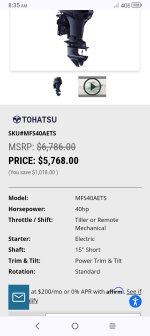
Yep, that's the only one I could find, too.l - confirming what Tod learned and confirmed by my local vendor.Google brought me right too it.
Here is a sketch, more or less to scale. Top "as designed", bottom has the addition 9" of length fore to aft, and 3" in width taken from each flotation chamber. The blue is the "insert" that brings the splashwell up to deck height, but that still allows water to get to the splashwell.I'm having trouble understanding your plan, If you are mocking it up, post a pic when done. My thought is that you are thinking of locating the dog's spot over what would typically be the motor well. The absolute last place I'd want a dog is on top of the motor well and in front of the motor, but maybe I'm not understanding your plan. A dog anywhere near the rigging would be a nightmare when they launch themselves in our out of place, the wiring and fuel lines aren't exactly fragile, but dogs aren't exactly gentle. Not that dogs aren't always in the way already, but you are training them that their place is to be right in the way, their safe spot is going to be to jump right up on the tiller whenever they think it is or want it to be time to hunt.
There are some of the larger boat blind boats that have full width wells with dog platforms. Look at the Bankes larger ones, maybe the duckwaters. These are only really feasible on a really beamy boat as you are having a hard time fitting the dog somewhere. Boats with a stern dog platform are just a totally different class of boat in terms of size.
It seems like you are committing to a tall blind 100% and while a good tall blind works well for divers, you will be limited for puddle ducks unless up against some sort of significant cover.
I drawed up this idea for you:
View attachment 63979
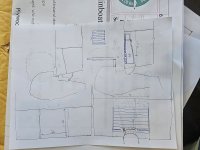
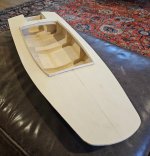
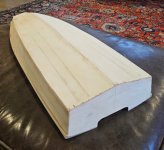
It is a lot of cockpit, unless you're really planning to hunt 3 regularly. I'm not, so shrinking it makes sense - and squaring it is logical, too. I really like your blind setup, but leaning towards removeable flapboards, too.I've always went back-and-forth with if it made sense to square up (rectangle up) the cockpit (that is a LOT of cockpit in day-to-day hunting. I made locking covers for mine and that would have made it a lot easier. I don't know if that little bit extra cockpit you get benefits anything. If you go with a typical high blind the squaring up may make the whole thing easier to make. I think my decks along the side must be wider than designed from the looks.
To do it again, I would 100% build flapper boards rather than a blind and a flat side deck and straight cockpit combing would be a big benefit.
On the dog box thought. What about taking the front deck and flattening off a platform on the front. Kind of partly inset into the crown of the deck. You could make it slatted like you wanted for draining and it would make the front a real nice casting platform. Would be sharp to do it in teak slats.
We think too much alike! Front dog deck is definitely an option. The obvious downside is dripping water into a relatively dry chamber (and likely gas and maybe battery).
We may have both been overthinking it, Tod. If I use the front deck for the dog, water will just roll off the deck. I could flatten it a bit, and am now thinking of taking a little crown out, anyway, for fishing. And I'll need some non-skid of some form for both.I was thinking a well underneath that the slatboard drops into.
We may have both been overthinking it, Tod. If I use the front deck for the dog, water will just roll off the deck. I could flatten it a bit, and am now thinking of taking a little crown out, anyway, for fishing. And I'll need some non-skid of some form for both.
Got my order in with Raka for Resin and glass, checking out wood soon. Need to do some shop cleanup and prep, then get to work on some sawhorses.

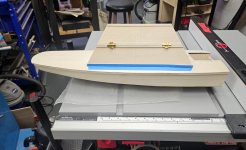
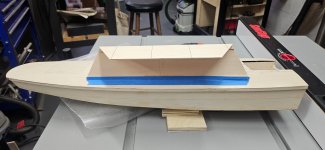
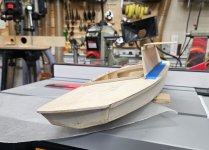
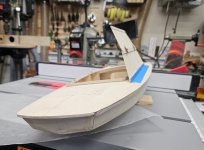
I'm going to play with some ideas alongside the build so once I have the hull done and flipped I can do real mock-ups. I'm seeing some of the synthetic blind material pop up on sale now that the season is over, so will buy a few different samples to have on hand. My gut says to just have the lower flapper boards (single) and extend above that with grass and the like (at least for the shooting side), but we'll see. The lower boards would certainly suffice when hunting solo if shooting over the stern - or maybe leave them off entirely and pull canvas over most of the cockpit.Henry,
I've been contemplating some of the same things you are in regards to flapper boards, etc. I spoke with the owner of Blind Grass and he said his product will stand unsupported 16." To my way of thinking, our flapper boards don't need to be full width. My goal from the start was to build a blind that allows shooting from the sitting position to accommodate my needs as I get older. Therefore my plan is to do a combination of a carriage style dodger and flapper boards. Richard
